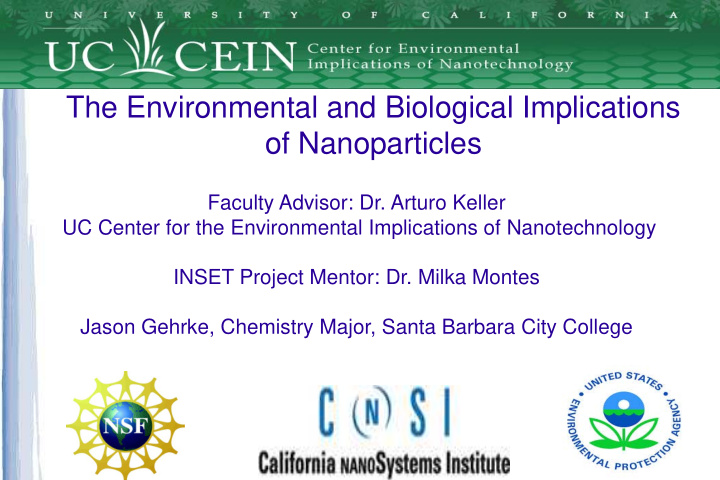



The Environmental and Biological Implications of Nanoparticles Faculty Advisor: Dr. Arturo Keller UC Center for the Environmental Implications of Nanotechnology INSET Project Mentor: Dr. Milka Montes Jason Gehrke, Chemistry Major, Santa Barbara City College
Nanoparticle Lifecycles Expand on the knowledge of nanoparticles (NPs) Increase understanding of NP life cycle During use and after entering environment Interactions with biological systems http://www.futurity.org/science-technology/designer-dots-could shield-food-chain/ 2
Silver Nanoparticle Size http://www.jnanobiotechnology.com/content/figures/1477-3155-3-6-1.jpg 3
Amino Acid Adsorption and NP Behavior TiO 2 and Ag-citrate NPs - Widely used in consumer products Effects of ionic strength, pH Stability of suspension: -Amino acid adsorption -Surface charges http://pubs.acs.org/doi/full/10.1021/es1042832 -Aggregation 4
Determining Suspension Characteristics Spectrophotometry http://en.wikipedia.org/wiki/File:Spetrophotometer-en.svg Dynamic Light Scattering 5 http://en.wikipedia.org/wiki/File:DLS.svg
Zeta Potential and Suspension Stability 6 http://www.bioresearchonline.com/article.mvc/Automated-Protein-Characterization-With-The-M-0002
Environmental Thiol Concentrations Bell, 1997 7
Ag, L-Cysteine Complex Aggregation pH < 8.0 - pH > 8.0 Time (min) 8 Samples: Ag NPs (1 mg/L), L-cysteine (10 mM), NaCl (10 mg/L)
Ag-Cysteine Complex as Function of Ionic Strength, pH Ag-Cysteine Absorption Spectra 0.25 Ag Control 0.2 (10mg/L) 0.15 Absorption Cys pH 7.0 10mM 0.1 NaCl 0.05 Cys pH 9.0 10mM 0 0 200 400 600 800 1000 -0.05 Wavelength (nm) 9
Formation Mechanism Cohen-Atiya et al , Journ. Elec. Chem., 2002 10
Cysteine Adsorption Conformation Coadsorption of chloride ion with cysteine + + - Ag NP + + + + + 11
Complex Formation as a Function of IS Ag, L-Cysteine Particle Size 1200 60 Hydrodynamic Diameter 50 1000 40 (nm) 30 Hydrodynamic Diameter (nm) 20 800 10 0 0 20 40 60 80 100 120 140 Time (min) 600 400 Ag-Cys, pH 7.1, 1 mM NaCl 200 Ag-Cys, pH 7.1, 10 mM NaCl 0 0 20 40 60 80 100 120 140 160 12 Time (min)
Ag-Cysteine Complex in Environment 13
Complex Characterization • Formation is highly dependent on pH, IS, and concentration of L-cysteine • Chloride ions are coadsorbed on Ag surface with cysteine • Complex results in aggregation or disaggregation of NPs based on IS • Prevents stabilization by natural organic matter (NOM) 14
Future Research • Environmental Scenarios - involving freshwater with natural organic matter • Adsorption isotherms – characterizing the Ag-cysteine complex formation as a function of cysteine concentration • Fate of Ag-cysteine complex 15
Ag-Cysteine Count Rates, [NaCl]=10 mM 16
Complex Formation and Aggregation 17
Recommend
More recommend